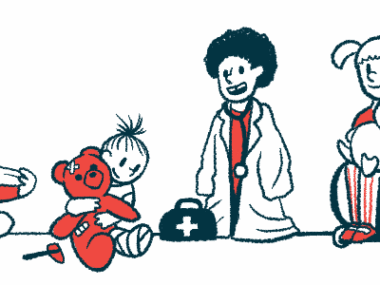Phase 3 trial of pitolisant for PWS expected to launch by year’s end
Harmony to test if therapy can reduce daytime sleepiness in patients
Written by |

Harmony Biosciences plans to launch a Phase 3 clinical trial by year’s end to investigate whether pitolisant can safely and effectively reduce excessive daytime sleepiness in children, adolescents, and adults with Prader-Willi syndrome (PWS), the company said.
The trial will be registrational, meaning that, if positive, the findings would back an application for regulatory approval of pitolisant for PWS. The therapy already is approved in the U.S. for treating daytime sleepiness and other symptoms in adults with a sleep disorder.
The design of the upcoming study in PWS patients was discussed with the U.S. Food and Drug Administration (FDA) in an end-of-Phase 2 meeting that primarily covered the positive findings from a proof-of-concept Phase 2 trial (NCT04257929). Top-line data from that ongoing study offered evidence that pitolisant could safely ease daytime sleepiness in PWS patients of all ages.
“We are pleased with the outcome of our End-of-Phase 2 meeting with the FDA as we prepare to initiate our Phase 3 registrational study, which aims to further investigate the efficacy and safety of pitolisant as a potential treatment for excessive daytime sleepiness in individuals with Prader-Willi syndrome,” Kumar Budur, MD, chief medical officer at Harmony, said in a company press release.
Positive results seen in earlier Phase 2 study of pitolisant in PWS
In addition to PWS’ hallmark feature of insatiable hunger, excessive daytime sleepiness has been reported to affect 52%-100% of PWS patients. Both symptoms are thought to arise from dysfunction in the brain’s hypothalamus, an area responsible for maintaining the right balance in the body’s core functions — including between sleep-wake states, and hunger and satiety.
Pitolisant is an oral treatment that’s thought to ease sleepiness by boosting the release of histamine, a molecule that promotes wakefulness, in the hypothalamus.
Harmony acquired U.S. rights to the therapy from its original developer, Bioprojet, in 2017. Pitolisant was later approved in the U.S., under the brand name Wakix, for treating excessive daytime sleepiness or sudden loss of muscle tone in adults with narcolepsy, a sleep disorder.
Now, Harmony is evaluating whether pitolisant also can ease daytime sleepiness in PWS patients — an indication for which there are no approved treatments.
The ongoing Phase 2 trial, which started enrollment late in 2020, was designed to test pitolisant as a potential treatment for excessive daytime sleepiness in people with PWS.
A total of 65 patients, ages 6-65 and all with excessive daytime sleepiness, were randomly assigned to receive either a low or a high dose of pitolisant or a matching placebo. The participants were given an oral tablet once daily for 11 weeks, or about 2.5 months, during the study.
The pitolisant dose was increased up to the final, target dose — which varied based on age — over the first three weeks, after which a stable dose was given for the remaining eight weeks, or about two months.
Changes in excessive daytime sleepiness were assessed with the Epworth Sleepiness Scale for Children and Adolescents (ESS-CHAD; parent/caregiver version). Scores on this scale range from 0 to 24, with lower scores reflecting less daytime sleepiness. A score drop of least two points is considered clinically meaningful.
Top-line results indicated that pitolisant led to a clinically meaningful drop, of 3.7 to 5.5 points, in ESS-CHAD scores across all dose and age groups. The strongest reductions were observed in children ages 6-11, according to Harmony.
In children and adults, but not adolescents, there was a clinically meaningful difference between the pitolisant and placebo groups, which was largely driven by patients who received the higher dose of the therapy.
The lack of such differences among adolescents was likely due to the fact that the placebo response was three times greater in this age group than among children and adults.
Over half of all patients in proof-of-concept trial responded to treatment
More than two-thirds of patients (70%) treated with pitolisant’s high dose were considered treatment responders, defined as those with a three-point or greater ESS-CHAD score drop or a total score of up to 10 by the end of therapy.
Among the patients given the low dose, 55.6% were considered treatment responders, as were 52.6% of those on the placebo.
Safety findings were consistent with pitolisant’s known profile, with the most common side effects being anxiety (11.9%), irritability (9.5%), and headache (7.1%). No serious adverse events were reported in the pitolisant groups.
After completing the 11-week treatment period, most participants entered a multi-year, open-label extension phase, in which all will continue to receive pitolisant at the maximum age-related dose until the end of the trial, expected by 2028.
While the findings support the use of pitolisant for PWS, the proof-of-concept trial was designed only to offer evidence of the treatment’s efficacy. It was not powered to demonstrate statistical significance. That will be the job of the future Phase 3 study.
“Building upon the encouraging data obtained from our Phase 2 signal detection study, we remain committed to advancing our development program for pitolisant in pursuit of a new indication in people with PWS, given the high unmet medical need in this population,” Budur said.







